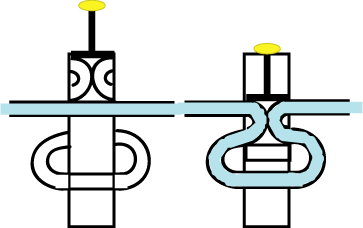| << Chapter < Page | Chapter >> Page > |

Valves are more commonly found on brass instruments. Pressing a valve makes the air flow through an extra section of tube, temporarily making the instrument longer in between the mouthpiece and the bell. The slightly longer instrument gets a slightly lower fundamental harmonic , and a lower harmonic series . (A few valves are ascending valves , which cut off a section of tubing and so raise the pitch.) Press the button in this animation to see how the air gets redirected through one type of ( descending ) valve.

The figure and the animation show one type of piston valve. Other styles of valves, including rotary valves as well as other types of piston valves, have different arrangements for the air flow inside the valve, but the purpose is always to redirect the air when the valve is pressed, opening up or cutting off a section of tubing.
Most brass instruments can play an entire chromatic scale with just a few valves. They use small changes in the embouchure to get many different notes from the harmonic series for each valve. But woodwinds have many more keys and fingerings available. Typically a woodwind can play the notes in an entire octave just by changing fingerings. Then a large change in the airstream and embouchure is needed to switch to the next harmonic , so that the next octave can be played. This big change is called overblowing .
Some brass instruments may also have a spit valve , a small hole that is normally closed but that the player can open quickly with a small key. This is not used while playing the instrument. It is used to empty the instrument of what players call "spit". Water vapor from the warm, moist breath of the player condenses in the instrument, especially when it is cold. (And, yes, there's probably a little actual spit in it, too, but not much). This can cause a bubbling sound in the tone. The spit valve is placed at a spot where the water naturally accumulates (due to gravity), giving the player a way to quickly empty the instrument during rests.
Calling the two main wind sections of the orchestra woodwinds and brass is a bit misleading. The important difference between the two groups is how the sound is first produced, not what the instrument is made of. (In a "brass" instrument, the lips are buzzed against the rim of the mouthpiece. In a "woodwind", the sound begins either with one or two vibrating reeds, or at a sharp edge in the mouthpiece.)
"Brass" instruments are usually made of brass, an alloy of copper and zinc. They may be the normal color of brass metal, or they may be tinted to a different metallic color. For example, nickel may be added to the alloy to give the instrument a silver color. Occasionally brass instruments are not made of metal at all; for example, the sousaphone, a tuba used in marching bands, is often made of (lighter-weight) fiberglass.
"Woodwinds" are often made of hardwood, but saxophones are normally made of brass, and most orchestral flutes are made of "nickel-silver" brass. There are also good-quality plastic woodwinds that may be preferable to the wooden versions in some situations - for example, playing in rain, heat, or cold.
Other materials are often needed to make an instrument work well. Felt pads, pieces of cork, metal keys, and various oils help to keep the valve and key action quiet while keeping the instrument from leaking air in the wrong places.

Notification Switch
Would you like to follow the 'Understanding your french horn' conversation and receive update notifications?